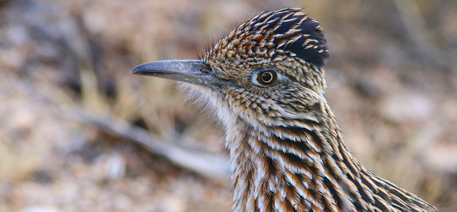Thank you to everyone who participated in the pilot season of Desert Avicaching. While the game is currently closed, we hope to reopen it for this topic or others in the future.
View our initial results
- Access the Desert Avicaching Report 2018
- Check out our SJV eBulletin article for a summary of results and lessons learned from the project
What is Avicaching?
Avicaching, created by the Cornell Lab of Ornithology is simply eBird + Geocaching: searching specific locations to spot as many birds as possible. With geocaching, people go to specific sites to find treasures. With Avicaching, eBird Hotspots are the locations and the birds are the treasures.
But it’s not just a game. The data collected by Avicachers fill in gaps in knowledge and help guide management and conservation decisions. Birders go to designated eBird hotspots, follow specific bird observation protocols, and submit their checklists. The result? Avicachers get a fun new game to play while birding, and eBird collects valuable data to help guide future bird monitoring and conservation efforts.
Desert Avicaching
The Sonoran Joint Venture region is large and has many under-birded areas. Part of our region includes the Mojave and Colorado deserts of southern California, an area that faces pressure from alternative energy development. While alternative energy, like solar, holds great potential, it also has impacts on birds and habitat. Both the conservation community and the alternative energy community have a need to understand these impacts. The SJV and our partners want to know more about how and where these efforts affect birds. In addition to the impacts to wildlife from the footprint of the installations themselves, migratory birds passing through the area on their way north or south are likely impacted. But we don’t have a solid understanding of which species, nor of the scope of the impacts. This makes it challenging to decide where and how to best spend mitigation dollars from developers.
The SJV, Bureau of Land Management, Point Blue Conservation Science, and Great Basin Bird Observatory want to use eBird to change this by launching the first Desert Avicaching game. That’s where YOU come in!
How do I play?
Earn points by visiting any of our Avicache locations (identified eBird Hotspots) and submitting a complete checklist from that location. Desert Avicaching is now closed.
Where do I go?
Check out our Avicaching locations by opening the 2018 Desert Avicaching Map below. Use your phone to navigate to a designated Avicaching location. As eBird Hotspots, these locations are also visible in your eBird mobile app on iOS and Android phones when you submit checklists.
Note: Safety is the highest concern. While all Avicaching locations can be reached by vehicle, the desert is something to always approach with preparation and respect. These Avicaching hotspots may be on terrain that is rough, rugged, and remote. Please be prepared with plenty of gas, water, food, and sun protection. Cell reception may be very limited. You can be of great help to others by notifying us of road washouts, unexpected high clearance requirements, or other access issues. Please let us know if you have any concerns about a particular road or location that you have visited.
What are the rules?
If possible, make your observations before 10 am or after 7 pm. Each checklist must last for a minimum duration of 20 minutes and a maximum duration of 60 minutes. If you travel further than one mile or bird for longer than one hour, no problem: just start a new checklist. You must submit a complete checklist of all the birds you can identify over the 20-60 minute period.
You may notice that some points have “Desert Thrashers” at the end of the Avicache name. The Desert Thrasher Working Group is studying seasonal distribution patterns for several thrasher species. You can add to our thrasher knowledge and increase survey coverage by visiting these desert thrasher points as part of Desert Avicaching. If you have questions about Desert Thrasher points in Nevada, contact Lauren Harter. For Desert Thrasher points in California, contact Chris McCreedy.
Scoring, Prizes, and Rankings
Each complete checklist submitted following the above guidelines earns you one point that contributes toward your Avicaching score. Every person who submits at least one point-earning checklist from a Desert Avicaching location is eligible for a prize drawing at the end of the Avicaching game. The more points that you earn during the course of the competition, the higher your chances of winning the drawing. Each point enters your name once into the random drawing. For example, if you have 15 points, your name is entered 15 times; 50 points, 50 times, etc. Prizes include binoculars and other birding gear, t-shirts, hats, conservation organization memberships, and more!
In addition to the prize drawing, there is also a ranking for the most checklists and total species seen in Avicache locations. The Avicacher who has the highest cumulative species list at the end of the Avicaching season will win the species category; the Avicacher who submits the most checklists will win the checklist category. We will also select a random winner each month from that month’s participants.
Avicache scores and total species tallies are updated in real-time. Click on the button below to view current scores.
Have more questions? Contact Chris McCreedy.
Thanks to the generosity of the following companies and organizations for providing prizes:
- American Birding Association
- Athlon Optics
- BirdsEye Nature Apps
- Point Blue Conservation Science
- Wildwings Backyard Nature Store
- PhoneSkope


